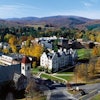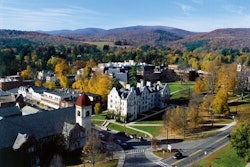The Asian and Pacific Islander American Scholarship Fund and the National Commission on Asian-American and Pacific Islander Research in Education (CARE) have secured $2 million in foundation grants to fund one of the largest research projects to explore Asian American and Pacific Islander (AAPI) college student success.
The funding announcement came late last month during the Asian and Pacific Islander American Scholarship Fund (APIASF) third annual education summit in Washington D.C. More than 200 people attended, including college and university presidents, scholars, and foundation leaders. APIASF and CARE announced the Partnership for Equality in Education through Research (PEER) project, a three-year $2 million initiative funded by The Kresge Foundation, USA Funds, and The Walmart Foundation.
Dr. Robert Teranishi, principal investigator for CARE, explained that the funding will address “the need for broader awareness about AANAPISIs and the need for research to play a role in understanding the capacity of AANAPISIs and the impact that they have on AAPIs.”
The primary purpose of PEER is to help realize the full degree-earning potential of the AAPI student community. PEER intends to support Asian American and Native American Pacific Islander Serving Institutions (AANAPISIs) by achieving greater institutional effectiveness, sharing resources for widespread AAPI student success, and obtaining more useful data about AANAPISIs to advocate for policies affecting AAPI student access and success in higher education.
Neil Horikoshi, APIASF president and executive director, told Diverse that, according to the 2010 census, “AAPIs are the most rapidly growing student population” in the U.S. In 1960, there were less than 1 million AAPIs in the U.S. As of 2010, there were more than 15 million. By 2050, the AAPI population is expected to approach 40 million. As a result, the proportion of AAPIs in the U.S. population has been rising and is expected to continue to rise. This shift in demographics is also reflected in higher education, where AAPI college enrollment is increasing at a high rate.
Consequently, organizations such as the Asian and Pacific Islander American Scholarship Fund (APIASF) and the National Commission on Asian American and Pacific Islander Research in Education (CARE) are working to address the obstacles facing AAPI students in higher education.
PEER will work collaboratively with De Anza College, City College of San Francisco, and South Seattle Community College, three AANAPISIs with a history of supporting AAPIs.
One of the major themes at the summit was the need to increase awareness of the challenges facing AAPI students. Umar Hafeez, an education summit speaker in 2011, said, “A lot of people have this idea that AAPI students are the highest achieving students. Before going to the higher education summit, I also had that viewpoint. After seeing the data, I realized that our community actually does need help.”
Teranishi explained that “there’s not enough research to adequately represent the needs and the challenges of the community and, as a result, AAPI students are often overlooked and misunderstood.”
Although Historically Black Colleges and Universities (HBCUs) and Hispanic-serving institutions (HSIs) have been recognized by the federal government as a part of The Higher Education Act of 1965, AANAPISIs were not formally recognized until 2007. Institutions eligible for AANAPISI status must have at least a 10 percent enrollment of AAPI students, with at least 50 percent of all students at the institution requiring federal financial aid.
If granted AANAPISI status, an institution is eligible to receive federal grants. Currently, nearly 41 percent of AAPI students attend these AAPI eligible institutions, which are only 3.4 percent of institutions nationwide. As of 2011, 52 institutions had the AANAPISI designation, although there were 148 institutions eligible–an increase from 116 in 2009. According to the 2011 CARE report, by 2013, 160 institutions will meet the necessary criteria.
Teranishi indicated that, even after the recognition of AANAPISIs, the misconception around challenges facing AAPIs still existed, even in the government. “There was still a perception in the government itself about the needs of Asian students. Some agencies were still saying they don’t consider AAPIs an underrepresented minority population,” said Teranishi. He added that, “the research we’ve done shows that this attitude is very damaging for the AAPI population.”
According to the CARE report in 2011, the two most significant problems facing AAPI students are access to education and completion of education. The report explains that, considering the cost of a four-year college, many AAPIs simply can’t afford it, especially those that come from poverty. As a result, they are forced to either abandon their education or attend a community college. Data shows that those AAPI students in community college have significantly more “risk factors” than those in four-year colleges. These “risk factors” are correlated to lower rates of persistence and completion.
In addition, Teranishi explained that vulnerable minorities exist within the AAPI community, who are often overlooked. The 2011 CARE Report found that, in the U.S., although less than 25 percent of the Filipino and Asian Indian population have never enrolled in postsecondary education, that figure rises to more than 60 percent in the Hmong, Laotian, and Cambodian communities. Further, fewer than 40 percent of Hmong, Laotian and Cambodians even have a high school diploma or equivalent. In addition, Southeast Asians and Pacific Islanders have a high rate of attrition during college — over 50 percent for Native Hawaiians, Tongans, and Samoans.
Horikoshi explained that on a positive note, “I need information to do my job and they gave us the funds to go do it, so in turn, now we’re on a very steep trajectory to gather more critical information. This is about the democratic mission of higher education and we’re just a small part of it, but right now, a big part of it because we are a leading voice.”
He added, “We talk about access and success, but more importantly, we’re in the process of building vibrant communities throughout the United States by targeting where the largest concentration of AAPIs are gathered. It’s a huge strategy, but very realistic and one I know we will achieve in time.”















